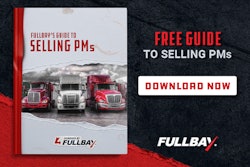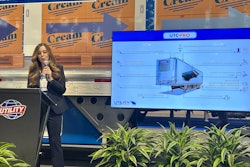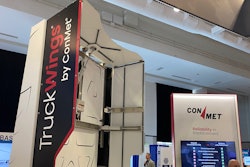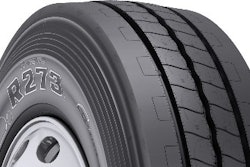When it comes to fleet equipment, every investment decision is scrutinized through the lenses of safety, efficiency, and return on investment. That’s why grille guards for Class 5-8 trucks often become the subject of debate in fleet management circles.
These heavy-duty front-end protectors are designed to shield the front of a truck – especially expensive and critical components like radiators, engines, hoods, and headlights – but they're still widely misunderstood.
There are several misconceptions fleets have about the purpose of grille guards and the types of fleets they’re intended for. Many assume these guards are for fleets operating in rural areas and that if animal strikes aren’t a concern, the impact on a truck's fuel economy and overall ROI just isn’t worth it. But that’s proved to be a misnomer.
Grille guards are not just ‘deer guards’
If you ask around, you'll often hear grille guards casually referred to as “deer guards, moose bumpers, or cattle guards” as if their only purpose is to prevent damage from animal strikes. It's an easy shorthand, especially in rural regions where wildlife collisions are a real concern. But the notion that grille guards are only for trucks operating in deer and other animal-heavy corridors is a narrow view of their utility.
While it’s true that grille guards can dramatically reduce the impact of animal collisions, they serve a much broader purpose. Urban and highway driving environments are full of unexpected hazards – everything from sudden traffic slowdowns that can lead to bumper-to-bumper impacts with other vehicles to poor weather conditions that increase the likelihood of collisions. Even minor incidents caused by distracted drivers or accidental errors like hitting load docks, guard rails, parked vehicles in the yard, and other fixed object collisions can be mitigated from front-end protection devices (more on this later).
A grille guard acts as a first line of defense, helping absorb and deflect force from a range of front-end incidents, not just a buck crossing the road at dusk. In fact, many fleets that utilize grille guards for front-end protection have reported reducing their towable incidents by up to 80% post-installation.
They do not reduce fuel economy
There’s a common belief among fleets that adding a grille guard will noticeably drag down a truck’s fuel economy. The theory is that adding any extra equipment to the front of the truck increases aerodynamic resistance, leading to more fuel consumption and higher operating costs. As more fleets emphasize running the most aerodynamic trucks coupled with technologies to maximize fuel efficiency and reduce fuel costs, that’s understandable.
But the reality is that the best grille guards on the market are engineered with aerodynamics in mind, and many on the market have a minimal impact on fuel economy. Quality manufacturers design their products to minimize airflow disruption while still providing robust protection. Many of today’s grille guards are made from lightweight yet durable steel or advanced composite materials, meaning they add very little weight to the front end. In general, grille guards with a curved frame and round tubing bars complement the aerodynamics of a truck more than a traditional square bar design.
For some, it might come as a surprise that many grille guards offer an almost unnoticeable impact on a truck’s overall fuel economy numbers. In fact, real-world testing with carriers using an Ex-Guard XG-150G3 grille guard model has shown the effect on fuel economy to be less than 0.4 gallons per 1,000 miles for the most protective (full-size) grille guard. Translated, that’s about 50 gallons of fuel per 125,000 miles. For a bumper-only protection device, the impact on a truck’s fuel efficiency is nearly zero. Fuel efficiency results can vary fleet-to-fleet, but the point is that installing a front-end protection device won’t take a toll on your fuel bills. And when you compare that negligible decrease to the potential savings in repair costs, downtime, and towing, the math starts to favor grille guard installation rather quickly.
There’s an ROI even if a truck doesn’t hit anything
This one might sound logical at first glance. If a truck goes its entire lifecycle without a major front-end incident, why bother spending money on protection that was never “used?” But this line of thinking ignores the broader reality of fleet risk management.
Grille guards are like insurance policies – they’re not just about what did happen, but what could have happened. Fleets are constantly balancing risk vs. reward, and the unpredictable nature of trucking – weather events, tire blowouts, distracted drivers, mechanical failures – means every trip carries a certain level of exposure.
More importantly, minor incidents happen far more frequently than catastrophic ones. A low-speed bump at a dock, a fender bender in a tight lot, or even road debris kicked up on the highway can result in front-end damage. These incidents might not make headlines, but they do rack up costs – both in terms of repair bills and downtime. And a surprising number of fleets don’t have great systems in place to document vehicle damage and costs associated with these events. Replacement parts continue to get more expensive, and the uncertainty surrounding tariffs will likely contribute to that. And as more fleets continue to spec trucks with the latest ADAS systems, the cost to replace collision-mitigation radar systems that are installed in the truck’s bumper is not cheap.
In fact, when a truck experiences front-end damage without any protection device, on average, a fleet can expect to pay anywhere from $10,000 to $15,000 or more depending on the severity of the incident. And that doesn’t factor in opportunity costs – downtime of a truck that requires servicing or a replacement part, which can often exceed $1,300 per day according to customer surveys. Grille guards pay for themselves many times over by preventing or minimizing the damage from these common, day-to-day occurrences. Not only that, but grille guards are also designed to outlast the lifecycle of a truck, so they can be fitted on the replacement truck (assuming the same make and model) or sold with the truck, which can increase its resale value.
Fleets that track incident data often find that a grille guard’s ROI can be realized with just one or two avoided repairs. Add in reduced insurance claims, less driver downtime, and improved truck availability, and the value becomes even clearer. And while not every truck will need to “use” its grille guard in a dramatic fashion, the peace of mind and protection it offers across a fleet far exceeds any initial cost.
![Nathan Holt[95] Headshot](https://img.ccjdigital.com/mindful/rr/workspaces/default/uploads/2025/05/nathan-holt95.b94OdOgF0s.jpg?auto=format%2Ccompress&crop=faces&facepad=3&fit=crop&h=48&q=70&w=48)













